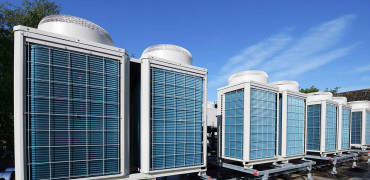I and many of my colleagues have been travelling around the country for the best part of three years now with our ‘Net Zero Roadshow’ – taking a renewable, low carbon message to different parts of the UK, and talking to designers, consultants, corporations, civil servants and even homeowners.
We’ve spoken as guests at exhibitions and conferences, as well as events we’ve put on ourselves and our central message is clear – the technology exists right now to help decarbonise your building.
Whist I’m pleased to say that awareness of heat pumps has increased somewhat over the past few years, there is still much to be done. And one thing that continues to surprise me is how many people still think heat pumps are just for houses!
Whilst homes are a vital part of the journey to net zero and replacing gas as the dominant form of heating is key to this, there is a big challenge in finding ways to stimulate and grow the market at pace.
At the moment, heating installers seem to be waiting for the domestic market to grow, while consumers are waiting for heat pumps to become more mainstream. Whilst it will happen, it’s a bit of a ‘chicken and egg’ situation!
The opportunities for commercial decarbonisation are much more readily achievable
Low hanging fruit
Commercially though, I firmly believe that there are significant potential savings in carbon emissions that we can achieve across the nation, if we focus on commercial buildings instead of only talking about how to remove gas from homes and replace them with heat pumps.
The opportunities are much more readily achievable and offer significant quick wins in terms of carbon reduction, both for businesses and the nation.
The commercial sector's gas consumption in England and Wales has remained fairly flat since 2012 with an approximate 2.5% reduction in gas consumption over that period according to the UK Government's Non-Domestic National Energy Efficiency Data Framework (160TWh down to 156TWh based upon the latest published data which only runs up to the end of 2022).
According to Ofgem, the average British household consumes 11,500 kWh of gas each year.
Using data from the Efficiency Framework, we can calculate that the commercial sector in England and Wales consumes the equivalent amount of gas as 13.5 million homes.
That’s each year, which is a lot of gas!
An ‘average’ commercial heat pump
A colleague of mine was trying to find a simple way of explaining the importance of commercial buildings in decarbonising the nation, however this is difficult to quantify with absolute certainty.
This is because a commercial heat pump installation can be anything from heating a dental practice, an office block, a hospital, a hotel, a school, or an entire leisure centre. That can result in a small installation of around 40-50kW of heating, right up to something that is supplying 1,000kW or more.
So, there isn’t a typical commercial installation, but collectively non-domestic buildings in England & Wales, consumed a total of 156TWh. 1TWh of gas is equivalent to 1 billion kWh of gas.
Breaking down that consumption we can see that the largest commercial consumers of gas are factories at 38% of total. At the same time, the office, education, health, hospitality and retail sectors each consume around 9-12 TWh of gas annually – That’s around 50TWh of gas that can be readily targeted for conversion to heat pumps!
Using the equivalent data set for domestic dwellings (National Energy Efficiency Data Framework), there are 18.7 million homes in England & Wales which have a gas supply. These homes consumed nearly 206 TWh = 206 billion kWh of gas in 2022 meaning that Non-Domestic buildings actually consumed a similar amount of gas to 75% of the entire England & Wales housing stock which are supplied with gas.
As there are only 1.75 million non-domestic buildings in England & Wales, the total 156TWh divided equally between these means that an average non-domestic building consumes around 89,000 kWh of gas per annum which is equivalent to the same amount of gas as nearly 8 domestic homes.
These are obviously average figures with some non-domestic buildings consuming considerably more than other (i.e. factories vs shops), however the non-domestic sector's smaller physical number of buildings means that a small reduction per building in this sector will have a significant effect on the UK's overall direct usage of gas in its buildings.
The end of gas for heating
With the focus from UK Government currently on how to reduce the gas consumption in domestic homes, it is only a matter of time before the non-domestic sector's thirst for gas overtakes the domestic sector, at which point, commercial building owners will suddenly find themselves under the spotlight
And the market is already moving quickly to remove gas, as tenants are now starting to ask about the sustainability of buildings before they will consider signing or renewing leases.
That means there is a real opportunity for designers, consultants installers and clients who understand how modern heat pumps can help future-proof the buildings they are working with.
We’ve prepared a free white paper on avoiding buildings becoming stranded assets.
Chris Newman is Zero Carbon Design Team Manager




